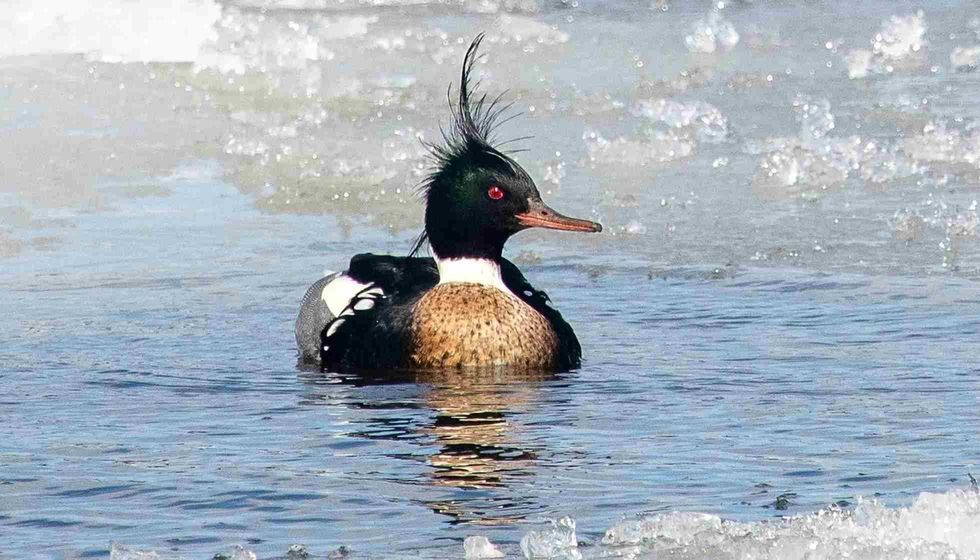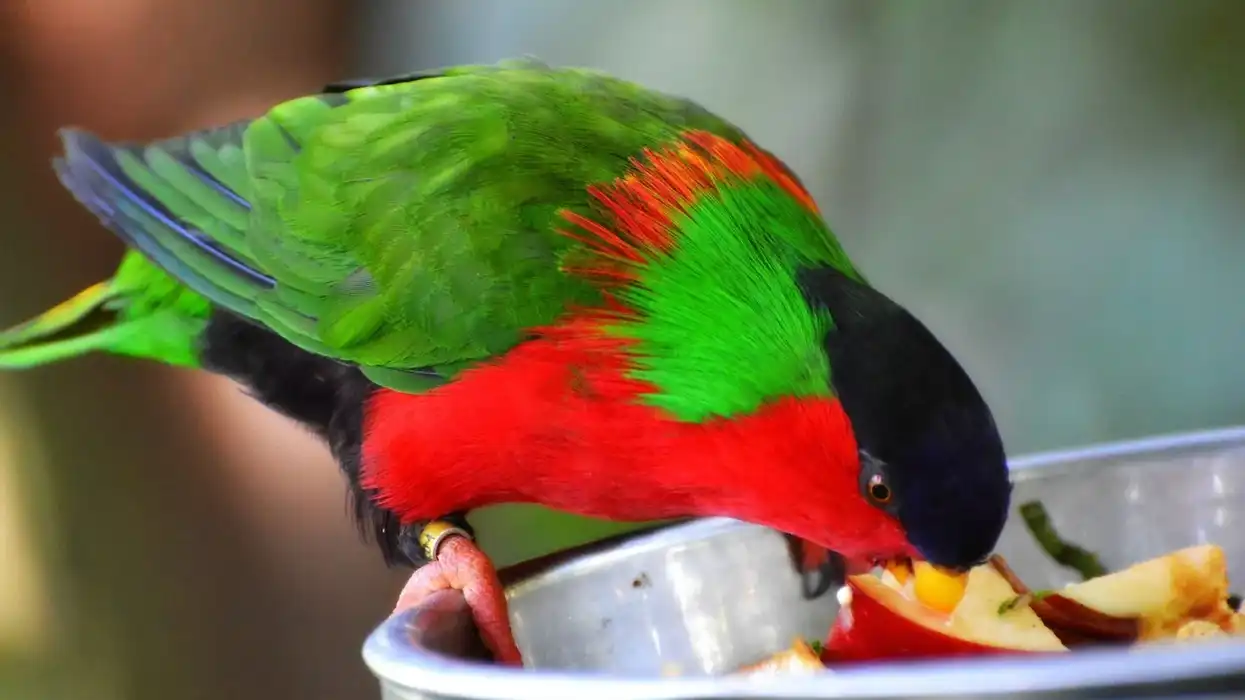There are three kinds of merganser ducks in North America. The red-breasted merganser (Mergus serrator) is a member of the dabbling duck family, which includes teals and pintails. The red-breasted merganser's range spreads across the Northern Hemisphere in the summer where they have their nesting grounds. The wintering grounds of these birds are saltwater wetlands along coastal shallow waters.
The red-breasted merganser (Mergus serrator) gets its name from the serrated edges of its bills. These shaggy-headed ducks are also called ‘sawbill’ due to their long bill with tiny serrations that help them to grip slippery fish. Red-breasted mergansers breed in the boreal forest on freshwater, brackish water, and saltwater wetlands that are usually close to coastal areas.
This species can be easily identified by their shaggy, uncombed-looking feathered head, long thin bill, round white neck collar. During the non-breeding season, the males and the females show less sexual dimorphism.
However, an adult male’s plumage changes and becomes more colorful to attract females. The breeding plumage of males includes a darker green head and shaggy crested feathers on the head. A female red-breasted merganser mostly has gray plumage with a reddish-brown head and a muted red bill.
If you wish to read more such facts, check out common merganser and hooded merganser.
Red-Breasted Merganser Interesting Facts
What type of animal is the red-breasted merganser?
Red-breasted mergansers are ducks found in the Northern Hemisphere. They are seen in coastal waters, estuaries, and saltwater habitats during the summer months.
Some of the main differences in common merganser vs red-breasted merganser are their preferred habitats. The common merganser favors freshwater lakes and ponds over saltwater habitats liked by red-breasted mergansers.
The breeding grounds of the two species are also different. The common merganser nests in cavities of large trees, rock crevices, and lighthouses. Red-breasted mergansers build their nest on the ground covered by low tree branches, rocks, and logs.
What class of animal does the red-breasted merganser belong to?
Red-breasted mergansers belong to the class Aves meaning they are birds. These ducks are European migratory birds that migrate between their summer breeding areas and areas in the south. They also fly as far as India, China, and various countries with milder climates during the winter season.
They are diurnal birds that are active during the day. Red-breasted mergansers are good swimmers and rapid flyers with strong white wings. While foraging as deep as 15-20 ft (4.5-6 m) these crested, aquatic red-breasted merganser ducks can remain beneath the surface of the water for almost a minute.
Red-breasted mergansers are not good on land and have an awkward walking style due to the position of their feet. Red-breasted merganser birds spend most of their time foraging and preying on small fish, crustaceans, and tadpoles.
How many red-breasted mergansers are there in the world?
Surveys indicate the breeding population of the red-breasted merganser species to be approximately 370,000.
Where does the red-breasted merganser live?
Red-breasted mergansers inhabit various areas in the Northern Hemisphere and have a wide range. Migration takes place during the breeding season and cold winters. They are found all throughout the year in coastal areas.
Their breeding grounds in the Americas include Alaska, northern Canada, and the northern United States. They can be seen in Minnesota, Maine, Wisconsin, and Michigan. These aquatic birds also breed in Greenland, Iceland, Ireland, Scandinavia, northern Russia, and Siberia.
They spend their winters along the Atlantic and Pacific coasts, the Gulf of Mexico, Great Lakes, inland waterways of southern limits till northern Mexico, Baltic, Black Sea, Aral Sea, and the Caspian Sea. In the breeding season, these ducks are common in northern areas of North America, mainly the boreal forests and open waters of the Tundra region.
What is a red-breasted merganser's habitat?
The red-breasted merganser species favor brackish water and saltwater wetlands and any open water body. In the summer season, they inhabit northern coasts, lakes, and rivers close to conifer forests and tundra.
Winter migration is towards the south and warmer countries towards protected waters along the sea coasts and inland lakes and rivers. Red-breasted mergansers mostly forage in standing shallow waters with submerged vegetation and abundant small fish prey and crustaceans.
The breeding grounds of these birds are in northern regions around the globe. In North America, it nests in Alaska, Great Lakes, northern Canada, and the Atlantic coast. There are two other merganser species in North America, the common merganser and the hooded mergansers, who prefer freshwater habitats more.
Red-breasted Mergansers dive underwater to prey on fish with their serrated bill. They often catch fish eggs, worms, shrimp, and crabs. They prefer foraging in shallow waters but this duck species hunts wherever prey is abundantly available. Sometimes these ducks dive in a formation to catch schooling fish like herring in coastal waters.
Who do red-breasted mergansers live with?
Red-breasted mergansers are highly social birds. These ducks with reddish-brown plumage usually live in groups except for the breeding season. Red-breasted mergansers even forage and nest near other bird species. In the breeding season, red-breasted merganser drakes and red-breasted merganser females make separate nests and mate in the breeding grounds.
The winter migration takes place in larger groups of up to 15,000 birds. Male red-breasted mergansers don’t defend territories as most birds do during the breeding season.
How long does red-breasted merganser live?
Red-breasted mergansers can live up to nine years in their wild habitat.
How do they reproduce?
The courtship display includes a salute of the male red-breasted merganser and the female holding her head high. The male then tips up the rear and puts the rear and the reddish bill high in the air. The female often jabs the male with her long bill responding to his courtship gestures.
Ideal breeding grounds of red-breasted mergansers are wetlands, fresh and brackish waters in boreal forests. Red-breasted mergansers nest on the ground where there is vegetation cover. Nesting grounds include marshes, coastal islands, sandy shores, and isolated islands in lakes. The red-breasted merganser drake leaves after mating and the female merganser hen builds and nests and raises the young alone.
The females always select a densely vegetated or hidden spot on the ground under driftwood piles, fallen logs, or under low tree branches near a water body. These ducks with brown plumage often nest alone or in colonies with other bird species like gulls and terns.
Females often pluck their own feathers to keep the nest warm. Females don’t lay all their eggs in one nest and use other birds’ nests too. That often leads to a brood containing up to 24 or even as many as 56 eggs.
What is their conservation status?
They are currently not considered under threat and their conservation status is Least Concern.
Red-Breasted Merganser Fun Facts
What do red-breasted mergansers look like?
Red-breasted mergansers are ducks that show sexual dimorphism. Males are more colorful than females. In the breeding season, the males get a deep green coloration on their shaggy heads. The chest has a cinnamon brown speckled coloration and the body is mostly gray-brown. Their greenish-black backs are bordered by a white patch.
Males have a distinct white neckband and steel-gray flanks. The red-breasted merganser wings are white on the underside and gray on the upper side. Both sexes have a long thin, red serrated bill and a crested head. Ruffled feathers on the head of these ducks are a distinct feature of this species.
In the non-breeding season, the males look almost like the females but with wider and more distinct white wing bars. Males and females both have double-crested plumes behind their heads. The body of the females is grayish brown and they have a visible small white wing bar.
The breast is whitish with gray speckles. Feathers on their head have reddish-brown coloration. The bills are more orange than red in the females and have a black tip.
Legs are reddish-orange. Females do not have breeding plumage and remain the same all through the year. Young red-breasted merganser birds resemble females.

How cute are they?
Red-breasted mergansers are unique-looking wild ducks abundantly found in their range.
How do they communicate?
Red-breasted mergansers use vocalization and visual displays in the breeding season to communicate with the young and with other members of the group. Red-breasted merganser call sounds like ‘garr’ or ‘grack’ when they sense danger and want to send alarm calls. Males produce a cat-like loud purr and howl yeow-yeow to attract females.
How big is the red-breasted merganser?
A red-breasted merganser that weighs 2.2 lb (1 kg) is about five times lighter than a Muscovy duck weighing 10– 15 lb (4.5- 6.8 kg). It is the largest duck species.
How fast can a red-breasted merganser fly?
Red-breasted mergansers are fast-flyers and can fly at a speed of up to 81 mph (130.3 kph)
How much does a red-breasted merganser weigh?
A red-breasted merganser’s body weight is around 2.2 lb (1 kg).
What are the male and female names of the species?
Female ducks of this species are called hens and the males are called drakes.
What would you call a baby red-breasted merganser?
Red-breasted merganser chicks are called ducklings.
What do they eat?
Red-breasted merganser birds mostly eat small fish. Young birds mostly eat worms. Occasionally, adult ducks also eat tadpoles, crayfish, and insects while they forage in the shallow waters.
Are they dangerous?
No, these birds live peacefully in their habitats within their range and are not dangerous at all for humans.
Would they make a good pet?
No, they are wild birds and would not be good pets.
Did you know...
Red-breasted mergansers have many predators. Eggs and nestlings are often eaten by ravens, gulls, mink, and parasitic jaegers. Adults are preyed on by birds of prey like owls, gyrfalcons, and animals like foxes.
Red-breasted mergansers sometimes prey on young salmons in fisheries in spawning streams. To stop them, the ducks are sometimes killed.
A group of red-breasted mergansers is called a team, brace, flush, raft, or paddling of ducks.
What is the difference between a goosander and merganser?
Red-breasted mergansers and goosanders have a similar shape and size, so they may be hard to tell apart. One of the best ways to distinguish between the two is to look out for tufted feathers on the heads of mergansers.
Another way to tell them apart is to notice how goosanders have a head and neck coloring that abruptly ends at the body, but the merganser's coloring slowly fades into the body color.
Is the red-breasted merganser good to eat?
Red-breasted merganser decoys are used for capturing these wild ducks like other waterfowl species for their meat. However, mergansers eat fish. Their meat has a taste that most people don’t enjoy.
Here at Kidadl, we have carefully created lots of interesting family-friendly animal facts for everyone to discover! Learn more about some other birds from our Radjah shelduck and the mottled duck pages.
You can even occupy yourself at home by coloring in one of our free printable Red-Breasted Merganser coloring pages.









